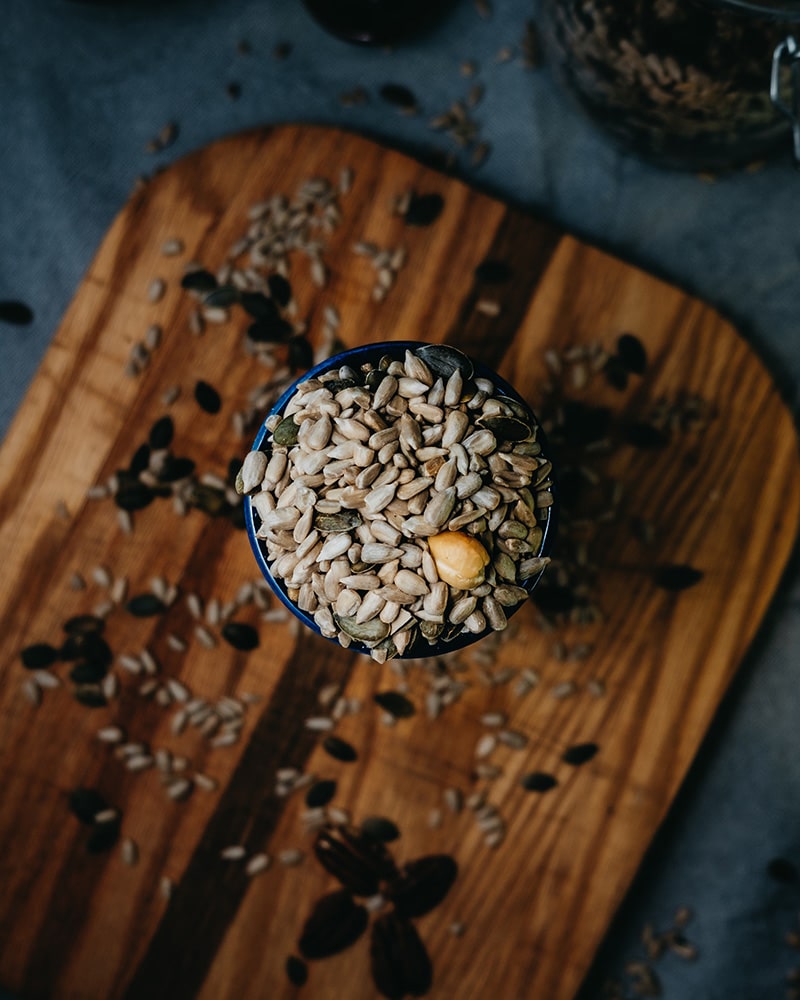Benefits from Vitamin E and What Foods to Eat
The benefits from vitamin E include enhanced immune function, healthy skin and eyes and prevention against clots from forming in heart arteries.
Benefits from Vitamin E and How they Work
Vitamin E is a fat-soluble vitamin with several forms, but alpha-tocopherol is the only one used by the human body.
Its main role is to act as an antioxidant, scavenging loose electrons—so-called “free radicals”—that can damage cells.

Antioxidant vitamins, including vitamin E, came to public attention in the 1980s when scientists began to understand that free radical damage was involved in the early stages of artery-clogging atherosclerosis, and might also contribute to cancer, vision loss, and a host of other chronic conditions.

Vitamin E has the ability to protect cells from free radical damage as well as stop the production of free radical cells entirely.
Vitamin E Deficiency
If you don’t get enough vitamin E, you may become more prone to infections, experience impaired eyesight or suffer from muscle weakness.
Vitamin E can easily be included in your nutrition. However, disorders that affect the absorption of fat, such as cystic fibrosis or liver disease, may lead to deficiency over time, especially if your diet is low in vitamin E.
The following are common signs of a deficiency:
- Peripheral neuropathy (damage to the peripheral nerves, usually in the hands or feet, causing weakness or pain)
- Ataxia (loss of control of body movements)
- Decreased immune function
An excellent starting strategy to reap the benefits of vitamin E is to add sunflower seeds or almonds into your diet.
You can also increase the absorption of vitamin E from low-fat foods by eating them with fat. Adding a tablespoon of oil to your salad for example can make a significant difference.

Daily Recommended Amounts for Vitamin E Intake
| Category | Vitamin E (alpha-tocopherol): Recommended Dietary Allowance (RDA) in milligrams (mg) and International Units (IU) |
| CHILDREN | |
| 1-3 years | 6 mg/day (9 IU) |
| 4-8 years | 7 mg/day (10.4 IU) |
| 9-13 years | 11 mg/day (16.4 IU) |
| FEMALES | |
| 14 years and up | 15 mg/day (22.4 IU) |
| Pregnant | 15 mg/day (22.4 IU) |
| Breastfeeding | 19 mg/day (28.5 IU) |
| MALES | |
| 14 years and up | 15 mg/day (22.4 IU) |
Sources of Vitamin E
Vitamin E is generally available in a wide variety of different foods, however knowledge is power and the information below will help you to make informed and intelligent decisions about your nutrition, in line with your health and fitness goals.
Vitamin E can be found in the following varieties of foods.
- Vegetable oils
- Seeds and nuts
- Fish
- Fruit and Vegetables

The following foods are high in alpha-tocopherol, which is the most active form of vitamin E.
Vegetable Oils
According to one study, the α-tocopherol equivalent for Brazilian oils ranged from 33 mg/100 g for sunflower oil to about 13 mg/100 g for olive oil and only a trace amount for coconut oil.
Most commonly used oils such as soybean, com, cottonseed, ricebran, and sunflower contain 17 to 33 mg α-tocopherol per 100 g of oil.
Wheat Germ Oil — 135% DV per serving
- 1 tablespoon: 20 mg (135% DV)
- 100 grams: 149 mg (996% DV)
Hazelnut Oil — 43% DV per serving
- 1 tablespoon: 6.4 mg (43% DV)
- 100 grams: 47 mg (315% DV)
Sunflower Oil — 37% DV per serving
- 1 tablespoon: 5.6 mg (37% DV)
- 100 grams: 41 mg (274% DV)

Almond Oil — 36% DV per serving
- 1 tablespoon: 5.3 mg (36% DV)
- 100 grams: 39 mg (261% DV)
Seeds and Nuts
Sunflower Seeds — 66% DV per serving
- 1 ounce: 10 mg (66% DV)
- 100 grams: 35 mg (234% DV)
Almonds — 48% DV per serving
- 1 ounce: 7.3 mg (48% DV)
- 100 grams: 26 mg (171% DV)
Hazelnuts — 28% DV per serving
- 1 ounce: 4.3 mg (28% DV)
- 100 grams: 15 mg (100% DV)
Pine Nuts — 18% DV per serving
- 1 ounce: 2.7 mg (18% DV)
- 100 grams: 9.3 mg (62% DV)

Peanuts — 16% DV per serving
- 1 ounce: 2.4 mg (16% DV)
- 100 grams: 8.3 mg (56% DV)
Brazil Nuts — 11% DV per serving
- 1 ounce: 1.6 mg (11% DV)
- 100 grams: 5.7 mg (38% DV)
Pistachios — 5% DV per serving
- 1 ounce: 0.8 mg (5% DV)
- 100 grams: 2.9 mg (19% DV)
Pumpkin Seeds — 4% DV per serving
- 1 ounce: 0.6 mg (4% DV)
- 100 grams: 2.2 mg (15% DV)
Pecans — 3% DV per serving
- 1 ounce: 0.4 mg (3% DV)
- 100 grams: 1.4 mg (9% DV)
Cashew Nuts — 2% DV per serving
- 1 ounce: 0.3 mg (2% DV)
- 100 grams: 0.9 mg (6% DV)
Fish and Seafood
Atlantic Salmon — 14% DV per serving
- Half a fillet: 2.0 mg (14% DV)
- 100 grams: 1.1 mg (8% DV)
Rainbow Trout — 13% DV per serving
- 1 fillet: 2.0 mg (13% DV)
- 100 grams: 2.8 mg (19% DV)
Abalone — 23% DV per serving
- 3 ounces: 3.4 mg (23% DV)
- 100 grams: 4.0 mg (27% DV)
Fruit and Vegetables
Avocado — 14% DV per serving
- Half a fruit: 2.1 mg (14% DV)
- 100 grams: 2.1 mg (14% DV)
Red Sweet Pepper (raw) — 13% DV per serving
- 1 medium pepper: 1.9 mg (13% DV)
- 100 grams: 1.6 mg (11% DV)
Mango — 10% DV per serving
- Half a fruit: 1.5 mg (10% DV)
- 100 grams: 0.9 mg (6% DV)
Turnip Greens (raw) — 10% DV per serving
- 1 cup: 1.6 mg (10% DV)
- 100 grams: 2.9 mg (19% DV)
Kiwifruit — 7% DV per serving
- 1 medium fruit: 1.0 mg (7% DV)
- 100 grams: 1.5 mg (10% DV)

Mamey Sapote — 39% DV per serving
- Half a fruit: 5.9 mg (39% DV)
- 100 grams: 2.1 mg (14% DV)
Blackberries — 6% DV per serving
- Half a cup: 0.8 mg (6% DV)
- 100 grams: 1.2 mg (8% DV)
Blackcurrants — 4% DV per serving
- Half a cup: 0.6 mg (4% DV)
- 100 grams: 1.0 mg (7% DV)
Cranberries (dried) — 4% DV per serving
- 1 ounce: 0.6 mg (4% DV)
- 100 grams: 2.1 mg (14% DV)
Spinach (raw) — 4% DV per serving
- 1 cup: 0.6 mg (4% DV)
- 100 grams: 2.0 mg (14% DV)
Cognitive Function and Neurodegenerative Diseases
Scientists seeking to untangle the causes of Alzheimer’s, Parkinson’s, and other diseases of the brain and nervous system have focused on the role that free radical damage plays in these diseases’ development.
But to date, there is little evidence as to whether vitamin E can help protect against these diseases or that it offers any benefit to people who already have these diseases.
Dementia
Some prospective studies suggest that vitamin E supplements, particularly in combination with vitamin C, may be associated with small improvements in cognitive function or lowered risk of Alzheimer’s disease and other forms of dementia, while other studies have failed to find any such benefit.
A three-year randomized controlled trial in people with mild cognitive impairment—often a precursor to Alzheimer’s disease—found that taking 2,000 IU of vitamin E daily failed to slow the progression to Alzheimer’s disease.
Keep in mind, however, that the progression from mild cognitive impairment to Alzheimer’s disease can take many years, and this study was fairly short, so it is probably not the last word on vitamin E and dementia.

Parkinson’s Disease
Some, but not all, prospective studies suggest that getting higher intakes of vitamin E from diet—not from high-dose supplements—is associated with a reduced risk of Parkinson’s disease. In people who already have Parkinson’s, high-dose vitamin E supplements do not slow the disease’s progression.
Why the difference between vitamin E from foods versus that from supplements? It is possible that foods rich in vitamin E, such as nuts or legumes, contain other nutrients that protect against Parkinson’s disease. More research is needed.
Benefits from Vitamin E – Countering Amyotrophic Lateral Sclerosis (ALS)
One large prospective study that followed nearly 1 million people for up to 16 years found that people who regularly took vitamin E supplements had a lower risk of dying from ALS than people who never took vitamin E supplements.
More recently, a combined analysis of multiple studies with more than 1 million participants found that the longer people used vitamin E supplements, the lower their risk of ALS. Clinical trials of vitamin E supplements in people who already have ALS have generally failed to show any benefit, however. This may be a situation where vitamin E is beneficial for prevention, rather than treatment, but more research is needed.
If you found this information on the benefits from vitamin E and want to improve your health further, then check out these articles on boosting your immune system, vegan protein powders or foods that contain high amounts of B12.




